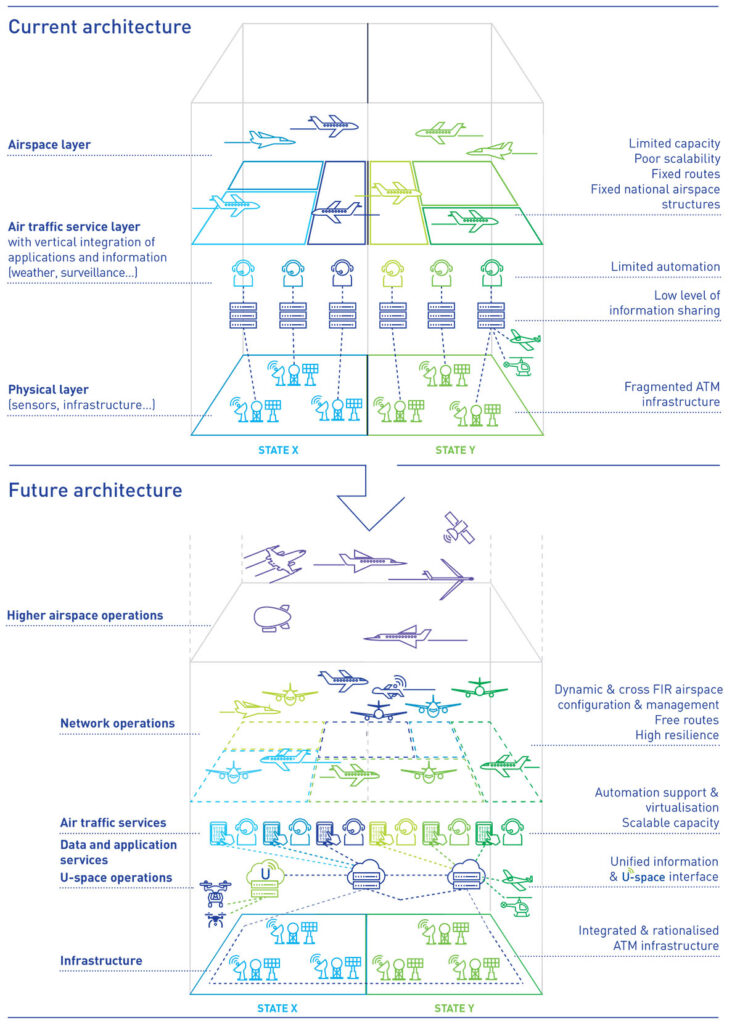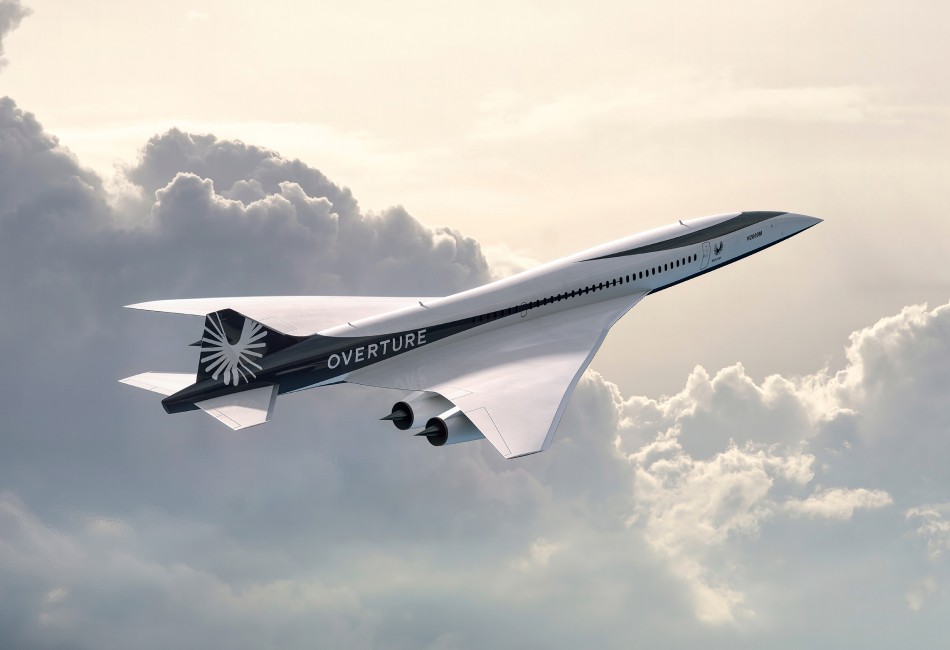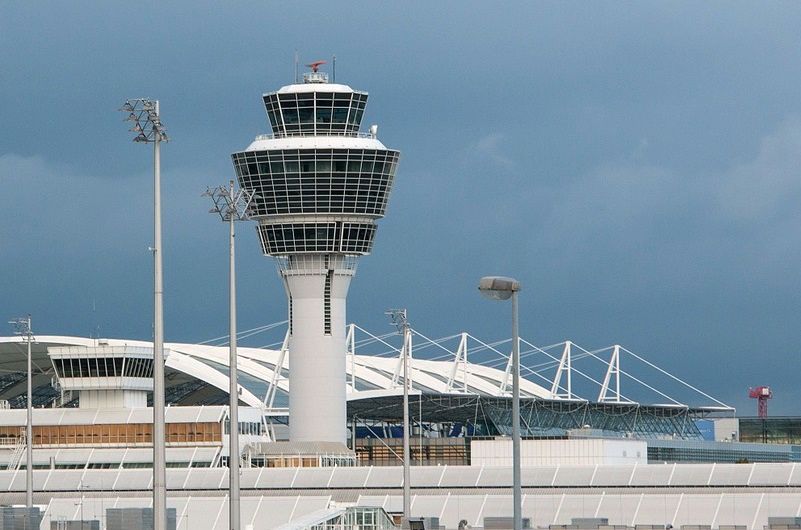30th September 2022
Written by: The Proficient Airman, Mubashar Yasin.
What is the Single European Sky (SES)?

The Single European Sky (SES) is an initiative to reform the current European airspace. The SES programme was set up to address challenges, such as capacity, fuel burn and CO2 emissions.
Currently, the European airspace is divided along national borders in the sky with most European countries cooperating through the EU aviation network manager, Euro-control. In addition to this, large areas of airspace are reserved for national military – and in most cases these remain out of use outside of exercise and training missions.
Therefore, the current airspace is outdated with borders failing to optimise flight paths and reserved airspaces contributing to significant financial and environmental costs.
What ambitions have been set for the Single European Sky?
- Enhanced safety via efficient air traffic management
- Pan-European co-operation of air traffic services
- Operational excellence and reduced delays: via releasing scarce airspace and direct routing through member states
- Demand-driven air navigation service and air traffic architecture to address capacity
- Integrated airspace management cell (AMC) – a dual-use military-civil flexible airspace
- Overall, lower carbon emissions and financial costs
The EU commission established the underpinning structure of the SES under four key components. These include:ss
From productivity (pan-European ATC), integrated services (implementing the functional airspace blocks for optimising performance) and network management (improved EU route network and the management of the Single European Sky ATM Research – SESAR)
Functional Airspace Blocks (FAB) is the re-structuring of a fragmented airspace into seamless airspace based on ‘operational requirements’ through cross border cooperation.
Currently, there are 9 FABs across 31 countries in agreement; two of which are formally recognised by the EU Commission. These are the UK-Ireland FAB and the Denmark-Sweden FAB. Since the UK-Ireland FAB was introduced in 2008 it has helped airlines save over €335 million and 330,000 tonnes of jet fuel. This an example of how well this initiative has the potential to work if successfully implemented all over the EU.
SESAR (Single European Sky ATM Research) Joint Undertaking is a partnership of member EU states to accelerate research, innovation and implementation of new systems (e.g. European ATM system) that replace obsolescent technologies from the fragmented EU aviation network.
Given increasing demands in travel and more congested airspaces, safety and regulation is paramount. For example, Euro-control role has extended to manage the EU ATM network and is in close co-operation with airports, airspace users, air navigation services and the military. In addition to this Eurocontrol supports EASA, the EU Commission and the national supervisory authority.
The EU commission advise for adequate investment to ensure airport capacity is managed accordingly to preserve capacity, efficiency, and safety across the EU network.
27th September 2022
Written by: The Proficient Airman, Mubashar Yasin.
EasyJet to upgrade their A320 fleet with fuel-saving enhancements.

By the end of 2023, EasyJet is set to upgrade their entire A320 fleet with a fuel-saving Descent Performance Optimisation (DPO) enhancement and a Continuous Descent Approach (CDA) system.
DPO and CDA works by enabling aircrafts to descent from cruise altitude by using only idle engine thrust. In addition to this, it enhances the on-board flight management system (FMS) for an efficient descent by enabling the plane to stay in the cruise-phase longer. In other words, the plane does not initiate the descent too early. This effectively removes or at least drastically reduces the ‘level-off’ state where the plane is flying horizontally and relies on thrust to fly straight, level flight prior to final approach.
EasyJet will save an astonishing 98,000 kg fuel per year per aircraft across its European network. This will in turn reduce carbon dioxide emissions by an excess of 311 tonnes per year per aircraft. EasyJet roadmap to net-zero emission by 2050 is heading in the right direction at least in the short term by investing millions in initiatives like this to reduce emissions.
Based on the EasyJet website in the last 20 years the airline has reduced carbon emissions per passenger, per kilometre by one-third through renewing their fleet and operating efficiently alone.
The implementation of the DPO software is yet another exciting prospect for EasyJet following the delivery of their first A320neo earlier this year. The new A320neo is equipped with the latest Satellite Landing system (SLS) technology which like the DPO software aims to improve efficiency and reduce fuel usage.
However, EasyJet believes more is to be done by governments and stakeholders to help them reach their net-zero target. One way this can be done is by modernising the airspace by implementing an initiative called ‘The Single European Sky’.
On the next news blog, I will explain in detail what exactly ‘The Single European Sky’ details and why airlines like EasyJet argue a need for this.
23rd September 2022
Written by: The Proficient Airman, Mubashar Yasin.
The Return of Concorde?

Almost two decades ago the Concorde would see its demise having completed its final flight from New York to London ending the supersonic era. Will Boom Supersonic, a Denver start-up company return the supersonic back to the skies?
Boom Supersonic is planning to deliver the supersonic Overture, dubbed the Concorde 2.0 in 2025 capable of flying 1.7 times the speed of sound. This is a very promising and exciting given the demand for business travel. However, whether Boom Supersonic has the technological advancement and resources to deliver their promise by 2025 is a separate matter.
Why will Overture succeed when Concorde didn’t?
Concorde was co-manufactured by France and the British. However, there were many limitations with the Concorde that led to its demise. Aside from the Air France Concorde accident on July 2000 killing all 109 on board, Concorde was already facing high operating costs. During the development alone the Concorde overran initial estimates by over 20 times and was forced to rely on Government subsidies and high ticket prices in order to operate. In addition to this Concorde was exceptionally loud and was notorious for noise complaints.
Technological advancement, such as material science and aerodynamics could all play in favour for Overture. Let’s take wind tunnels as an example. Rewind to the days of the Wright brothers, wind tunnels were paramount in determining aerodynamic characteristics and flight performance during aircraft development. Today with aid of software simulation we can optimise hundreds wind tunnel tests in a matter hours.
How is Overture different to Concorde?
Overture is to be built with carbon fibre composite. This is 40% lighter than aluminium, the primary material that made up the fuselage of Concorde. This will subsequently lower operating costs. Overture’s contoured fuselage will further optimise airflow to reduce drag and improve fuel efficiency.
Boom Supersonic plans to address the noise by powering Overture with four modern turbofan engines without afterburners to minimise noise pollution. In addition to this, the use of smaller engines means less thrust requirements and the quieter it is to run.
Unlike the Concorde, Overture plans to run on 100% sustainable aviation fuel (SAF) as it covers 5,000 miles at Mach 1.7. SAF delivers the same performance as conventional jet fuel but with a smaller carbon footprint.
Boom’s use of a complex fuselage – larger diameter in front and smaller diameter towards the back will further aid in maximising fuel efficiency at supersonic cruising speeds. This is complemented further with the installation of gull wings – a prominent bend in the wing inner section at the wing root section. This will enable air to flow smoothly around and over the aircraft to enhance the supersonic ability.
And finally, the average price for seat on the Overture will be comparable to a business-class subsonic flight at present. This is significantly lower than a flight on a Concorde – with the average price 20% higher than first class tickets on subsonic flights.
There has been a great commercial interest from the likes of American Airlines, United, Virgin Atlantic and Japan airlines. However, there’s one thing missing at present– and that is a partnership with an engine manufacturer. Since 2020, a partnership between Boom and Rolls-Royce was in place to build the engines for Overture but has recently terminated as of September 2022. There is no indication as to why but Boom plans to have a new partnership in place soon.
We can agree that there are unique challenges facing supersonic jet engine development. There needs to be a middle ground between noise at an acceptable level and speed for supersonic travel. Boom wants to fly 70% faster than the speed of sound whilst generating less noise and being environmentally friendly. Boom faces a difficult journey ahead to achieve its roll out in 2025 and subsequently carrying its first passengers in 2029. However, if it manages to achieve supersonic flight – this will no doubt revolutionise travel again and open a new avenue for better, sustainable supersonic travel in years to come particularly when modern-day technology is constantly evolving.
21th September 2022
Written by: The Proficient Airman, Mubashar Yasin.
French Air Traffic Strikes: Everything you need to know.

French Air traffic Strikes: Everything you need to know
The French Syndicat National des Controleurs du Trafic Aerien (SNCTA) union, the country’s biggest and main union for air traffic controllers staged a walkout arguing for better pay and more recruitment.
The French air traffic strikes are significant as over the years they have continued to affect countless thousands of travellers all over Europe. French airspace covers 14 million square kilometres across mainland France, the Mediterranean, Atlantic and overseas territories. All of which is used by major and budget airlines, such as Ryanair and EasyJet to connect to other countries.
As inflation sits at 6.6%, the country’s inflation rate has almost doubled since the start of the year. Based on this, the SNCTA argues pay needs to be in line with soaring inflation and the current economic situation.
In addition to this, their second argument reflects recruitment. Between 2029-2035 one third of the air traffic workforce is set to retire – this is roughly around 1,200 controllers. So there is a huge demand to fill in gaps within the sector. SNCTA argues it is vital this is addressed immediately given it takes an average of 3 years to fully train controllers.
Following no concrete guarantees from the Directorate for Civil Aviation (France) (DGAC) and the public authorities, this has led to an air traffic strike which has affected over 1000 flights departing and arriving in France, including overflights – flights transiting over French territory.
When did the French Air Traffic strikes occur?
The walkout took place on 6am on Friday 16th September to 6am on Saturday 17th September 2022. This is to be followed by a 3 day strike on 28th, 29th and 30th September. The 3 day strike will coincide with a nationwide strike by France’s General Confederation of Labour Union on 29th September.
what was the impact of the French Air Traffic strikes?
Europe’s biggest budget airline, Ryanair cancelled 420 flights affected 80,000 passengers. Whilst rival EasyJet cancelled 76 flights. British airways also cancelled 22 flights. The national carrier, Air France was also forced to cancel 55% of its short to medium haul; and 10% long-haul flights. In addition to this more than 400 flights departing from and arriving to Paris Charles de Gaulle and nearby airports were cancelled with a further 200 delayed. Further hundreds of flights were delayed as a result of this.
I also happened to be a passenger flying from Faro, Portugal (FAO) to London Gatwick, UK (LGW) on Friday 16th September. My flight BA2851 was scheduled for a short flight at 12:45 to 15:45. This was delayed for two hours, including one hour sat on the tarmac. Hundreds of passengers faced the same delays with terminals full of passengers waiting for their flights back. We were eventually airborne at 14:45 with an extra 1h05 mins to go around France.
Luckily enough, we managed to make it back despite delays. Unfortunately, a few friends who were also travelling back to Bristol and Manchester had their flights cancelled and had to travel the next day. We were one of thousands of passengers to be affected. Isn’t it fascinating to hear how a single scenario has a knock-on effect for thousands!
19th September 2022
Written by: The Proficient Airman, Mubashar Yasin.
Quiet over the skies of London

Quiet over the skies of London.
London Heathrow (LHR) makes special arrangements to ensure minimal disruption during the funeral procession to Windsor.
British Airways suspends its Wifi charges in order to let passengers to watch the Queen’s funeral at 35,000ft.
Across in France, in commemoration of Her Majesty Queen Elizabeth II the most “British” airport – Touquet Paris-Plage is to be renamed after the late Queen. The airport is popular amongst private fliers. At one point Touquet Paris-Plage airport was as popular as Paris and Nice airports (1950s).
In other news, Swedish engineers are working on the World’s first 30-seater all electric aircraft. This will no doubt support Sweden’s ambitious global emission targets to make all domestic flights fossil-free by 2030.
The aircraft will have:
- Fully battery powered ranging upto 200km
- Backup turbo generator (hybrid) powered by sustainable Av fuel.
The conversation on sustainability and reducing carbon emissions is being had in EVERY industry right this moment. And one thing is definitely clear – sustainability will play a massive positive change in years to come in the aviation sector – with new ways of thinking and collaboration. Exciting!
